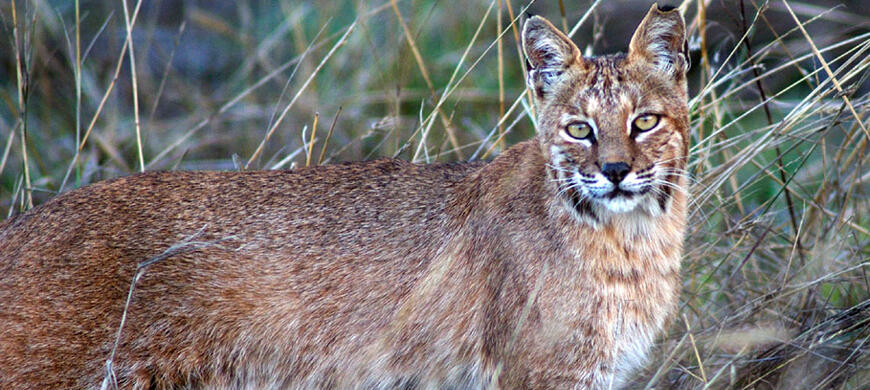Bobcat

Bobcats ( Lynx rufus) are among the most secretive of Kansas furbearers. They range throughout Kansas, but even where they reach the highest densities in the southeast, they are only rarely seen. Bobcats are usually only a leap away from cover, and closely associate with shrubby edges of riparian woodlands and field borders, timber, rocky ledges or outcroppings, ravines, and other brushy or generally broken habitat types. Their spotted fur provides excellent camouflage in these habitats, and their willingness to crouch and hide rather than to bolt across open spaces aids in their elusiveness.
A large tom bobcat will weigh about 30 pounds, and a partial description can be found in its names – the common name referring to the short, bobbed tail, and the species namerufus referring to the reddish coloration of many bobcats. Both male and female bobcats have a distinct white spot on the back of each ear, which may serve as a visual cue for kittens to follow the female through dense undergrowth. Though kittens are usually born in the spring, bobcats may breed and have young at any time of year. Two or three kittens per litter is average.
Like other members of the cat family, bobcats are highly adapted for predation. Strictly carnivorous, they hunt with keen senses of sight and hearing. Cottontail rabbits are usually their primary food source, but cotton rats, wood rats, and jackrabbits are also preyed upon when cottontails are scarce. Bobcats opportunistically take smaller rodents, squirrels, and birds, and to a lesser extent, beavers, muskrats, and porcupines. Masters of ambush, bobcats occasionally kill adult white- ailed deer, though they do so frequently only in Northern climates when snow conditions favor bobcat mobility and hunting techniques. Unlike canids and some of the other furbearers, bobcats rarely scavenge and do so only when carrion is fresh. However, they will cache and return to larger kills of their own.
Coyotes, great horned owls, and foxes may occasionally prey on young bobcats, but there is no significant predator of bobcats in Kansas, except perhaps for bobcats themselves. Much like domestic cats, male bobcats sometimes kill and eat kittens or juveniles. Probably the most important natural mortality factor is starvation. Kittens may starve during times of low prey availability, and inexperienced juveniles often have difficulty securing enough food to survive their first winter. Starvation rates are highest in unexploited populations where juveniles are forced into marginal habitat on the fringes of established adult home ranges. Home range sizes are highly variable, but probably average 2 to 4 square miles for females and twice that for males.
The bobcat has the highest individual pelt value of any Kansas furbearer, and Kansas ranks among the top states in annual bobcat harvest. During the 2001-2002 furbearer season, nearly 3,600 were harvested. Trappers account for about two thirds of the annual harvest, and hunters account for most of the remaining third. Because bobcats could be confused with some endangered species of cats from other countries, federal regulations state that all bobcats must be pelt tagged in order to leave Kansas. KDWP gathers other information on bobcats during the tagging process, and some of the best furbearer harvest information we have pertains to bobcats. Annual pelt tagging reports are posted here.
Dates: 03/01/2024 - 11/08/2024
Species: bobcat, red fox, and gray fox.
Legal hours for running furbearers is 24 hours daily. Furbearers cannot be killed or taken during the running season. A furharvester license is required to run furbearers. It is illegal to possess any firearm or other hunting or trapping equipment while pursuing these animals during the running season.
Dates: 11/13/2024 - 02/15/2025
NOTE: All furbearer hunting, trapping, and running seasons begin at 12:00 a.m. on opening day and close at midnight of closing day.
Species: badger, bobcat, mink, muskrat, raccoon, opossum, swift fox, red fox, gray fox, striped skunk, weasel.
Field Trail Permit - Furbearers and Coyotes.
Furbearers and Coyotes - Management Units
Hunting, Furharvestion, and Discharge of Firearms.
Furharvester License - Unlicensed Observer and Restrictions.
Furbearers - Open Seasons and Bag Limits.
Coyotes - Season
Nonresident bobcat hunting permit; tagging, disposal, legal equipment, shooting hours, and general provisions.










